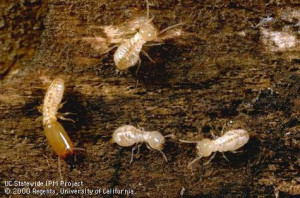When it comes to termites, an ounce of prevention is worth a pound of cure. Termites are just as damaging as they ever were, and in some parts of the country (including the San Diego area), new species, such as the Formosan termite, have arrived from other parts of the world to voraciously attack homes and properties.
A few years back, when the real estate market was booming, a lot of homeowners and business owners in our Sacramento pest control region didn’t worry much about termites; they figured by the time any damage was done, they’d have traded up to a newer or larger home or commercial property. These days the real estate market is a lot slower, and many of us are stepping back and planning to stay put for a few years. This means it is more critical than ever that we maintain and protect our existing properties… so that when the economy does turn around, and the time is right to make a move, we haven’t lost value due to negligence or damage.
The most effective way to protect your property is prevention. Our Sacramento pest control company encourages our customers to invest a small amount for an annual professional termite and wood-destroying organism inspection and avoid expending tens of thousands of dollars later on for expensive extermination and damage repair.
One of the most potentially damaging conditions in any structure is moisture. Dripping pipes, cracks in concrete foundations, deteriorated grout around windows and doors–any of these and more can create inviting conditions for termites as well as mold, mildew, fungus and wood rot.
Seventeen types of termites make their homes in California. Of those, the western subterranean termite (Reticulitermes hesperus) is the most destructive. Subterranean termites require moisture and must maintain a connection with the soil, either by boring tunnels through wood that touches the ground or by constructing mud-like shelter tubes.

Termite shelter tubes
Dampwood termites, which, as their name implies, live in moisture-saturated wood, are often found in beach houses, but some types, such as the Nevada dampwood termite (Zootermopsis nevadensis) live in drier highland areas. Drywood termites, which can survive long periods of time without any moisture, are most commonly found in Southern California, but some also occur in the Central Valley and on the coast.
A building can have more than one infestation of termites and may even be infested by more than one type. Our Sacramento pest control company uses integrated pest management techniques to (1) identify any potential points of entry to a structure or conditions that may lead to infestation, (2) repair leaks, apply moisture barriers or take other preventive measures, (3) eliminate all existing infestations. Following inspection, the property owner receives an official WDO (wood-destroying organism) report documenting the inspection results and any resulting treatment.
In this tough economy, all of us are looking for ways to economize and responsibly manage our investments. Your home or commercial property is one of the most important investments you will ever make. Consider carefully spending an ounce or two on termite and WDO prevention today to avoid several pounds of cure in the future!
As always, visit our pest control blog at https://www.earthguardpest.com/blog for more articles and information about termites.


